The short passing distances of around ten metres also promote good technical consistency amongst players, which aids the fluency of the exercises and their continuous rotation without them breaking down due to technical errors. When compared to larger circuits that involve sessions that are similar in length, the combination of a small playing area, coupled with good technical consistency, leads to a higher overall workload, and, as a result, the frequency of ball contact and technical interaction between players are increased.
In turn, this facilitates the training effect and potential for functional development, making the small grid a very efficient technical warm-up circuit, and an ideal circuit for concentrated technical exposure amongst young players.
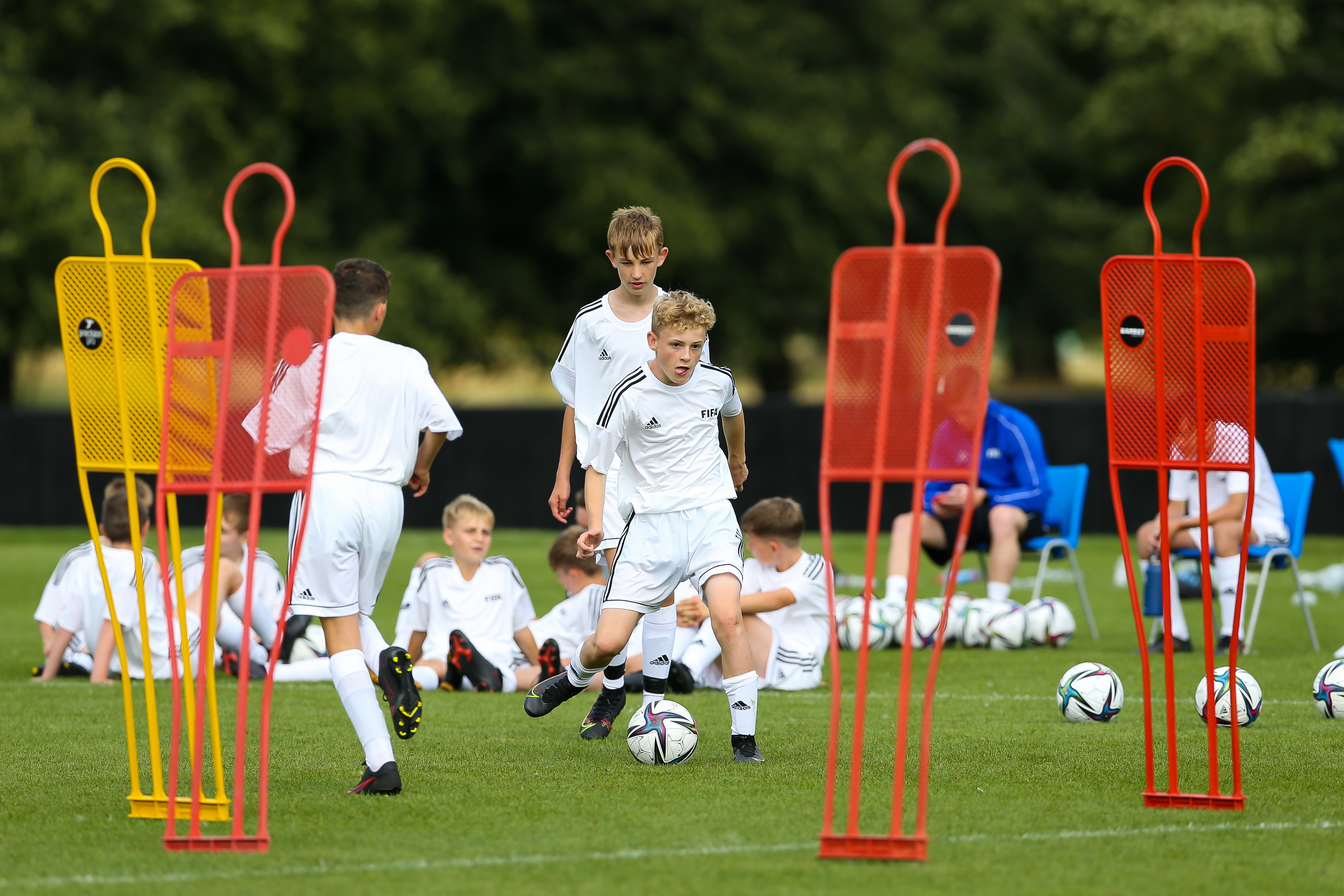
As with all technical activation circuits, functional development of young players is also targeted within these drills. The primary training objectives relate specifically to quick-footedness, movement, timing, passing quality, technical balance (two-footedness) and developing good footballing awareness habits. All of the above can be implemented in a training environment that requires technical cohesion between a small unit of players.
Another benefit offered by the circuit is that a total playing area of just 45x45 metres is required to cater for the needs of a complete 20-player squad. This can be implemented using four individual set-ups that comprise five or six players apiece.
To introduce the smallest grid set-up, we have 11 exercises, six of which represent new drills to the repertoire within this circuit. All of the new ones feature various receiving and passing scenarios that emphasise one- and two-touch passing and movement. Existing exercises have also been modified to reflect the smaller playing area and the variations in technical interaction between players.
Set-up for all drills
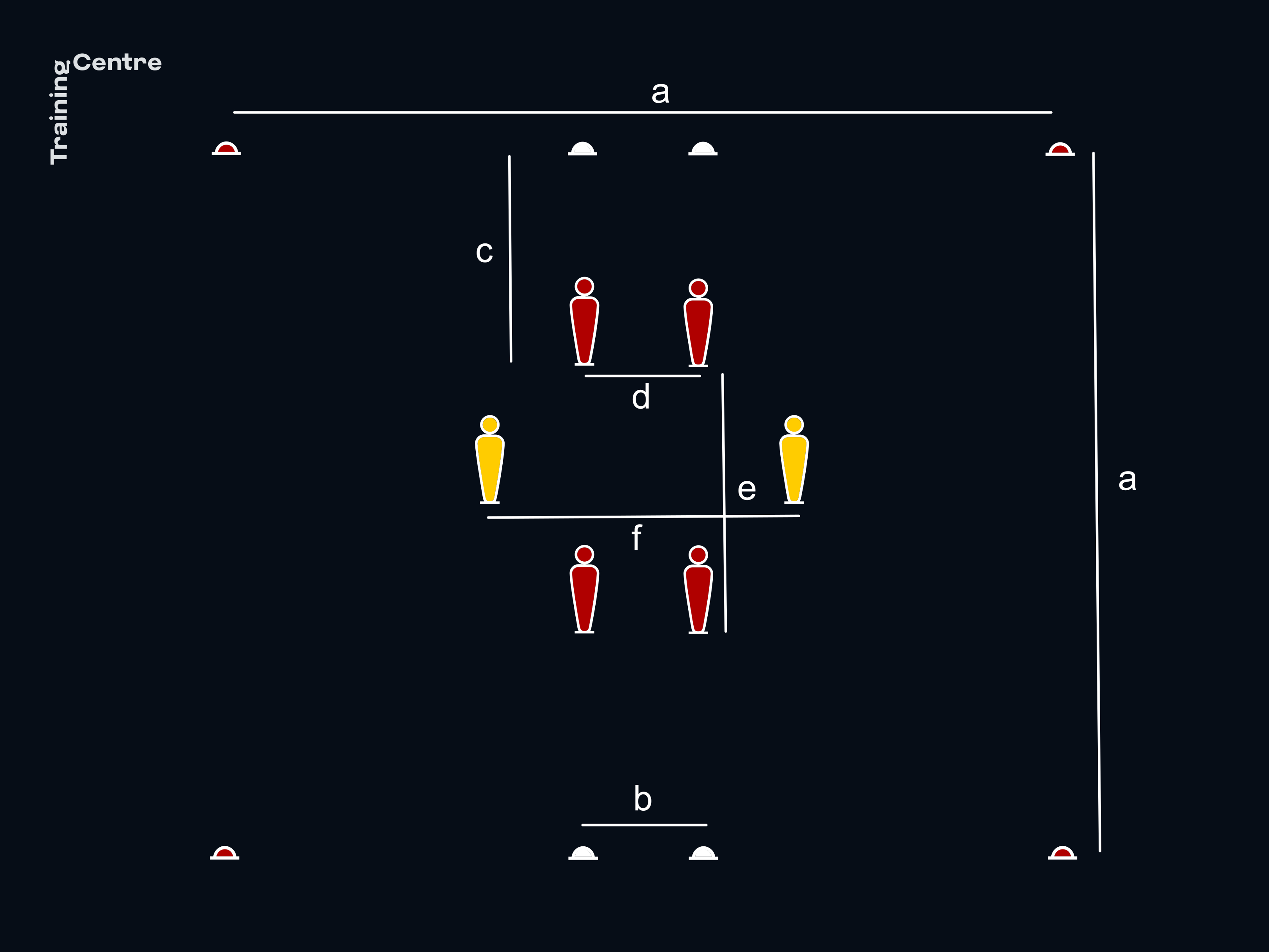
Organisation
- Mark out a 15x15-metre grid (a).
- Create 2 gates formed by white cones that are 2 metres wide (b).
- Travel 5 metres towards the inside of the grid (c) from both white cone gates and place two red mannequin gates that are 2 metres wide (d).
- These two mannequin gates should be 5 metres apart (e).
- Complete the set-up by placing a 6-metre-wide yellow mannequin gate halfway between the two red mannequin gates (e).
- If no poles are available, cones/discs may be used instead.
Drill duration
- 5-6 players: 2 to 3 minutes for drills with full left/right rotation. Two minutes for each variation for drills requiring left and right rotation.
Approximate workload intensity
- 5-6 players (optimum number): low to medium intensity.
Coaching points that apply to all drills
- Allow players 30 seconds to find their tempo and familiarise themselves with the scenario, before gradually raising the intensity demands.
- Devote a period of time (a minimum of 1 minute) during each drill to intensity, technical skills and the development of awareness habits.
- Encourage players to move quickly between positions.
Drill 1: move ball on first touch, play it on second

-
A plays a pass between the gate to B.
-
B quickly appears from behind the gate to occupy the space in front of it and, positioned as if set to peel away on the half-turn, lets the ball run across their body to the farthest foot, before pushing it forward and driving through the gate with their first touch.
-
With their second touch, B quickly plays a forward diagonal pass to C.
-
C then follows the same sequence with D.
-
Every player follows their pass so as to ensure rotation.
-
A moves to B.
-
B moves to C.
-
C moves to D.
-
Encourage "server" players (A and C) to be switched on and ready to play the pass quickly.
-
Players should play with their heads up and scan the area they are receiving the pass from and where they intend to pass to.
-
Place the emphasis on playing a quality pass into the path of the next player in the sequence.
-
This drill is technically balanced, requiring an equal use of left and right foot.
-
Players are to move the ball forward and into space with their first touch whilst on the half-turn, before quickly playing a diagonal pass with their second touch.
-
B should shift the ball on to their left foot and play a left-footed pass. D should shift the ball on to their right foot and play a right-footed pass.
-
To reinforce good footballing awareness habits, B should have a quick scan across to the diagonally opposite player before receiving the pass from A.
Drill 2: first-time pass down the line and coming inside
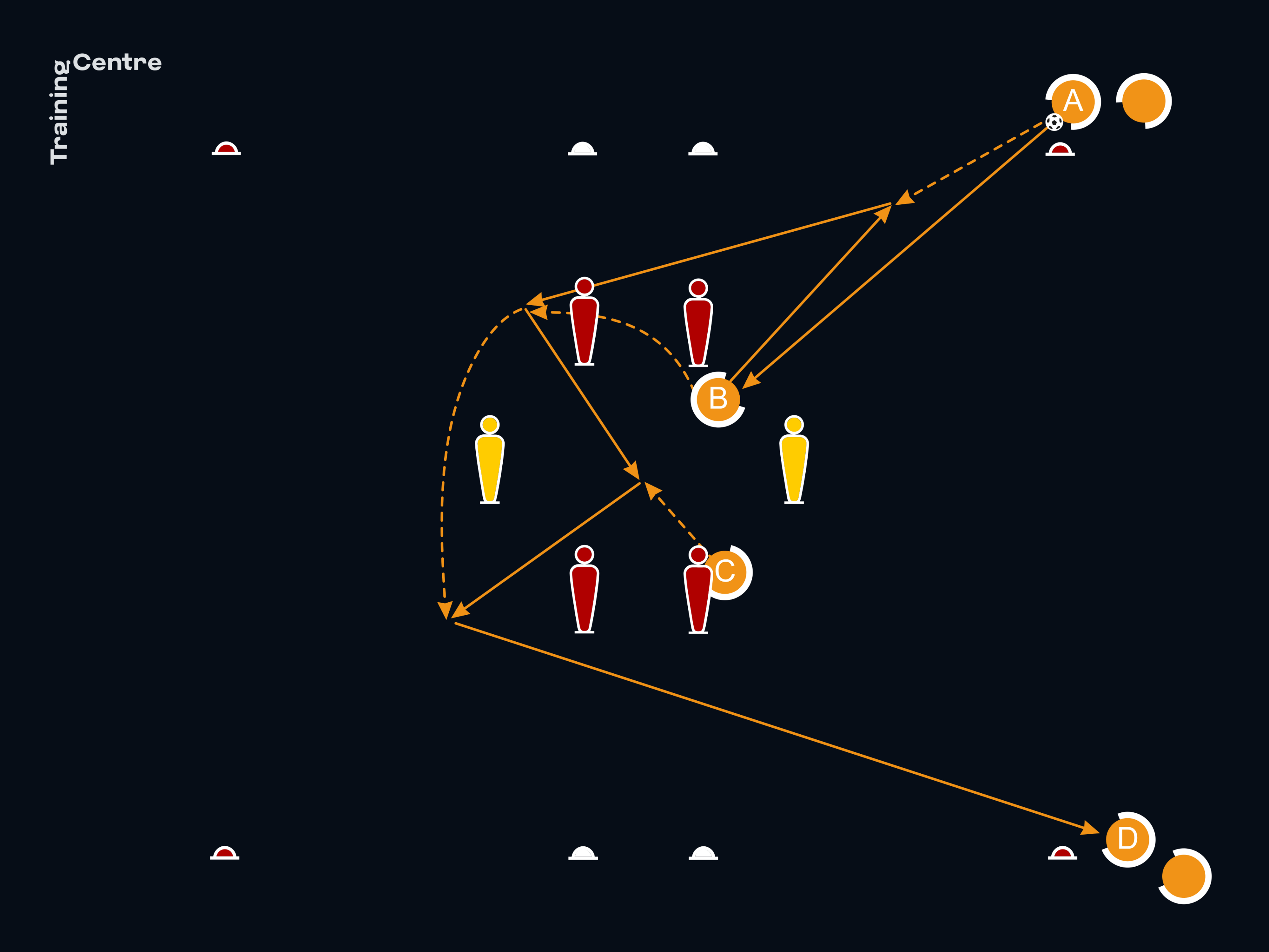
-
A plays a pass to B at the outer edge of the gate.
-
B appears from behind the gate and takes up a position on the outer side of it, before laying the ball back to A.
-
B then runs through the gate at pace and peels away on the half-turn.
-
B advances past the gate, taking a touch if necessary, before playing a diagonal pass to C.
-
B makes a straight run on the outside of the yellow mannequin to receive the lay-off played by C.
-
B completes the sequence by playing a first-time pass to D, who is situated at the other end of the grid.
-
D then starts the same sequence with C, who becomes the main player.
-
A moves to B.
-
B follows their pass to D.
-
After laying the ball off, C returns to the starting position and begins a new sequence with D.
-
Emphasise and encourage the one-touch and movement aspects of this drill.
-
Players should play with their heads up and scan the area they are receiving the pass from and the intended destination of their own pass.
-
Place the emphasis on playing a quality pass into the path of the next player in the sequence.
-
Where possible, play a first-time pass when changing direction.
-
Focus on the quality of the first-time lay-off and pass into the recipient's path.
-
This drill is technically balanced, requiring an equal use of left and right foot.
-
The initial diagonal pass should be returned to A with a right-footed pass.
-
The diagonal pass to C should be right-footed.
-
The diagonal pass to D should be right-footed.
-
The opposite feet to those stipulated above are to be used when D restarts the sequence (left foot, left foot, left foot).
-
To reinforce good footballing awareness habits, B should have a quick scan across to the opposite diagonal player before receiving the pass from A.
Drill 3: give-and-go, play outside, move diagonally inside

-
A plays a diagonal pass beyond the red gate into B's path.
-
B moves quickly wide of the gate to play a straight pass to C at the opposite end.
-
B moves diagonally inside to receive a return ball, meeting it with a first-time diagonal pass to D at the opposite starting position.
-
D then starts the same sequence with C, who becomes the main player.
-
A moves to B.
-
B follows their pass to D.
-
After laying the ball off, C returns to the starting position and begins a new sequence with D.
-
Emphasise and encourage the one-touch and movement aspects of this drill.
-
Players should play with their heads up and scan the area they are receiving the pass from and the intended destination of their own pass.
-
Place the emphasis on playing a quality pass into the path of the next player in the sequence.
-
Where possible, play a first-time pass when changing direction.
-
Focus on the quality of the first-time lay-off and pass into the recipient's path.
-
This drill is technically balanced, requiring an equal use of left and right foot.
-
In terms of coordination/cohesion, the emphasis is to be placed on the timing of movement and quick feet to create space, combined with first-touch and direction-change passing exchanges in tight spaces between a unit of players, with a specific focus on B.
-
For technical balance, when playing from the left side of the gate, B should move quickly away on the half-turn to play a straight left-footed pass, before moving quickly inside to meet the return ball with a diagonal right-footed pass to D in the opposite corner. The opposite applies when playing from the right side of the gate, with a right- and left-foot combination.
-
To reinforce good footballing awareness habits, B should have a quick scan towards the player at the opposite gate before receiving the ball from A.
Drill 4: lateral footwork combinations to create space for first- & second-touch passing

-
A plays a diagonal pass beyond the red gate into B's path.
-
B quickly moves wide of the gate to play a first- or second-touch one-two with C at the opposite red gate.
-
B then makes a quick countermovement shuffle across to receive the return pass between the gate, before shifting the ball beyond the mannequin gate on their first touch and playing a diagonal pass to D on their second touch.
-
D then starts the same sequence with C, who becomes the main player.
-
A moves to B.
-
B follows their pass to D.
-
After laying the ball off, C returns to the starting position and begins a new sequence with D.
-
Emphasise and encourage the one-touch and movement aspects of this drill.
-
Players should play with their heads up and scan the area they are receiving the pass from and the intended destination of their own pass.
-
Place the emphasis on playing a quality pass into the path of the next player in the sequence.
-
This drill is technically balanced, requiring an equal use of left and right foot.
-
In terms of coordination/cohesion, place the emphasis on manoeuvring the ball with quick feet across a lateral line while facing the play, using a combination of left and right footwork for straight and diagonal switch-play passing.
-
After quickly moving wide of the gate, B should be encouraged to play a first-time pass to C at the opposite gate.
-
For technical balance, when playing from the right side of the gate, B should quickly move away on the half-turn to play a right-footed pass. Moving the ball beyond the gate can be done with either the left or right foot to set up a left-footed diagonal pass to D.
-
The opposite applies when playing from the left side: the first pass is left-footed and the final diagonal pass is to be played with the right foot.
-
To reinforce good footballing awareness habits, B should have a quick scan towards the player at the opposite gate before receiving the ball from A.
Drill 5: three players switching play, with the focus on straight & diagonal passing

-
A plays a diagonal pass into the space between the red mannequin gate to B.
-
B moves quickly through the gate on the half-turn forward to play a first-touch give-and-go with C at the opposite red gate.
-
B then makes a short angled run to meet the return ball and plays a first-touch diagonal pass to D at the opposite starting corner.
-
D then starts the same sequence with C, who becomes the main player.
-
A moves to B.
-
B follows their pass to D.
-
After laying the ball off, C returns to the starting position and begins a new sequence with D.
-
Emphasise and encourage the one-touch and movement aspects of this drill.
-
Players should play with their heads up and scan the area they are receiving the pass from and the intended destination of their own pass.
-
Place the emphasis on playing a quality pass into the path of the next player in the sequence.
-
Where possible, play a first-time pass when changing direction.
-
Focus on the quality of the first-time lay-off and pass into the recipient's path.
-
NB: to promote complete technical balance, the directions should be inverted in the following sequence to encourage efficiency of movement and two-footedness.
-
In terms of coordination/cohesion, play the emphasis on switching play in tight spaces between a unit of three players, specifically focusing on B's movement, timing and quick feet coordination for first-time straight and diagonal passing combinations.
-
B should be encouraged to move quickly between the gate on the half-turn in preparation to play a straight first-time pass.
-
For technical balance, during the diagonal left to right sequence, B should let the ball run, meeting it with a straight right-footed pass and also play the diagonal pass to the opposite corner with their right foot.
-
During the right-to-left sequence, the emphasis for B is on left-footed passing.
-
To reinforce good footballing awareness habits, B should have a quick scan towards the player at the opposite gate before receiving the ball from A.
Drill 6: three players switching play, with the focus on the lay-off to the third player on the move
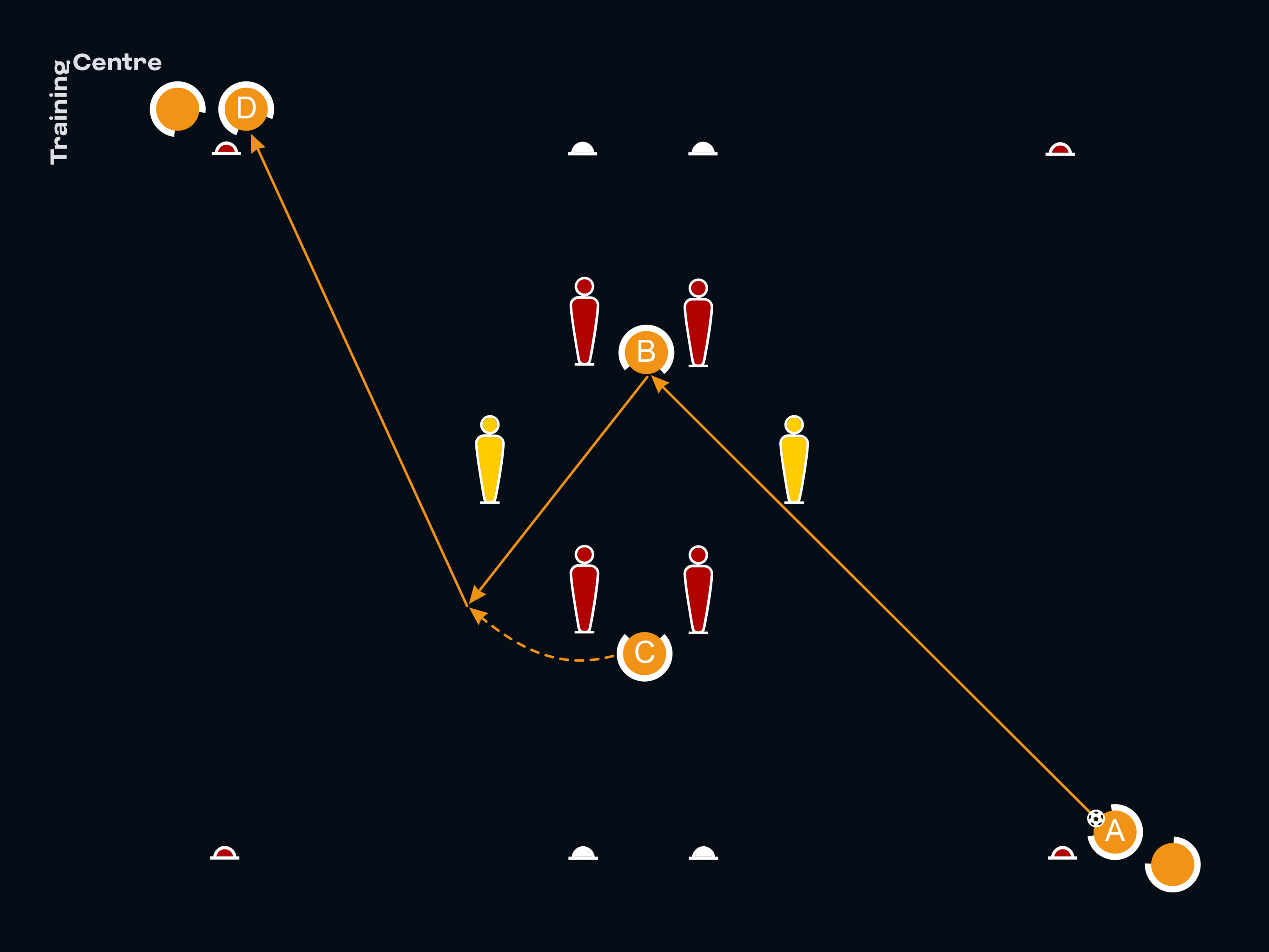
-
A plays a diagonal pass towards B, who is situated at the red mannequin at the far end.
-
B lays off a short, angled pass into C's path.
-
C moves wide of the yellow mannequin, meeting the ball with a first-time pass to D at the diagonally opposite corner.
-
D starts the next sequence with B, who becomes the main player.
-
A moves to C.
-
C moves to D.
-
D starts the next sequence with B.
-
Emphasise and encourage the one-touch and movement aspects of this drill.
-
Players should play with their heads up and scan the area they are receiving the pass from and the intended destination of their own pass.
-
Place the emphasis on playing a quality pass into the path of the next player in the sequence.
-
Focus on the quality of the first-time lay-off pass into the recipient's path.
-
Focus on the timing of player C's movement with the passing timing between A and B.
-
NB: to promote complete technical balance, the directions should be inverted in the following sequence to encourage efficiency of movement and two-footedness.
-
In terms of coordination/cohesion, place the emphasis on switching play in tight spaces between a unit of three players, combining first-touch diagonal passing, with a specific focus on the lay-off pass from B to the third player on the move (C).
-
For technical balance, during the diagonal left-to-right rotation, B can play the lay-off pass with whichever foot is appropriate in line with the receiving position and the quality of the pass from A. However, if the quality of the pass from A is good enough, B should be encouraged to open their body up and play a left-footed, first-time pass. The opposite applies during the right-to-left rotation.
-
To reinforce good footballing awareness habits, B should have a quick scan across towards C before receiving the ball from A.
-
For technical balance, during the diagonal left-to-right rotation, emphasis should be placed on C using their right foot to play the right diagonal pass. The opposite applies for the right-to-left rotation, with the emphasis placed on C using their left foot.
Drill 7: step in to play a short diagonal pass that meets a short, curved run in behind
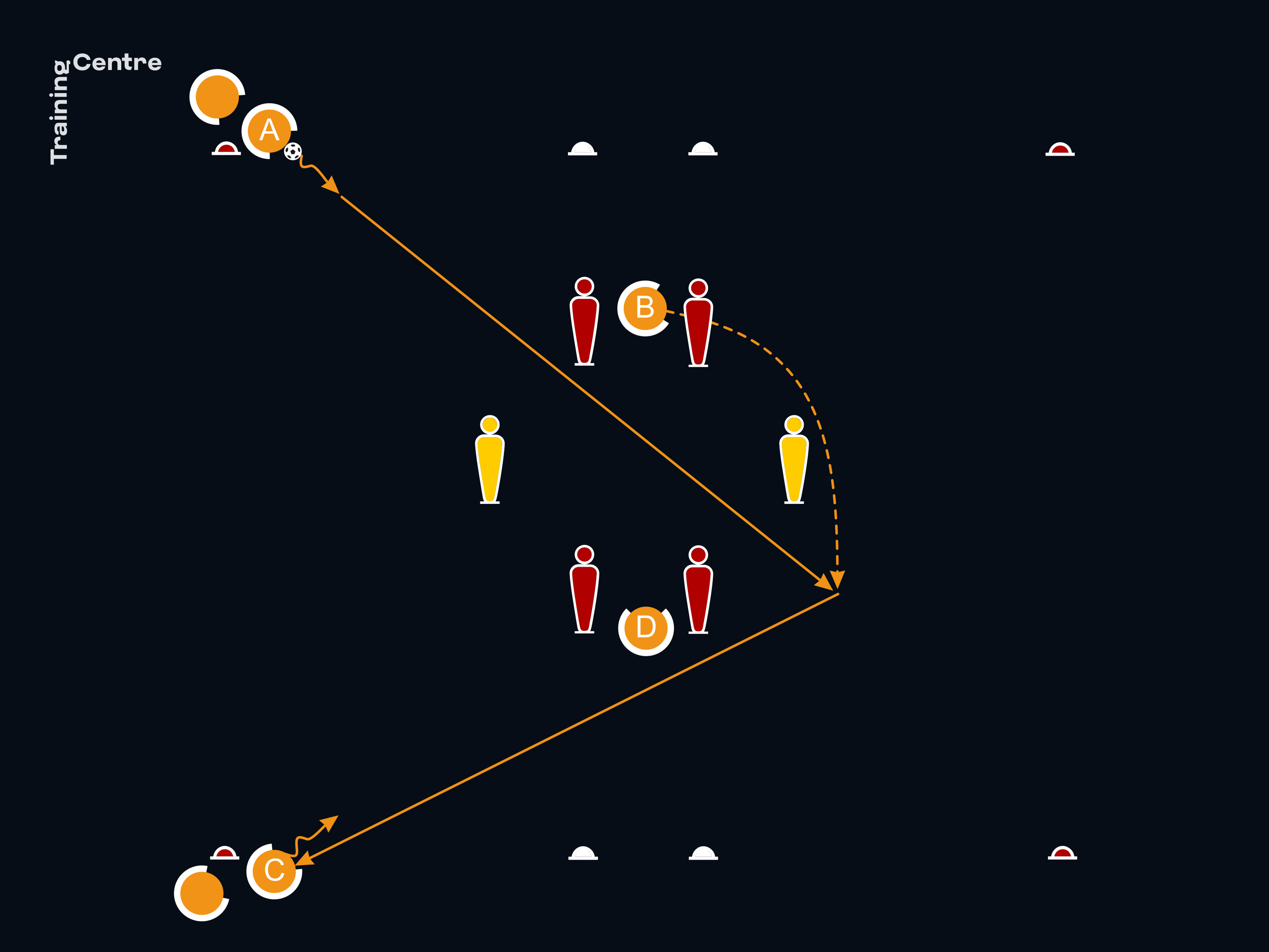
-
A plays a diagonal pass beyond the wide yellow mannequin into B's path.
-
B makes a short, curved run in behind the wide yellow mannequin to meet the ball and, if possible, plays a first-time diagonal pass to C at the starting position in the opposite corner.
-
C then starts the next sequence with D.
-
Every player follows their pass to ensure rotation.
-
A moves to B.
-
B moves to C.
-
Emphasise and encourage the one-touch and movement aspects of this drill.
-
Players should play with their heads up and scan the area they are receiving the pass from and the intended destination of their own pass.
-
Place the emphasis on playing a quality pass into the path of the next player in the sequence.
-
Focus on the coordination between B's movement and A's pass.
-
In terms of coordination/cohesion, place the emphasis on both the level of individual and collective technical quality between A and B to coordinate a short diagonal pass beyond a line with a short, curved run in behind.
-
This drill is technically balanced, requiring an equal use of left and right foot.
-
For technical balance, when playing the diagonal left pass, A should move the ball forward to set up a right-footed pass to meet the short, curved run behind from B. The opposite applies for the diagonal right pass, in which the emphasis is placed on the left foot.
-
For technical balance, during the left-to-right rotation, if possible, B should play the diagonal right pass first-time with their left foot.
-
The opposite applies for the right-to-left rotation, with the emphasis on right-footed passing.
-
To reinforce good footballing awareness habits, at the start of the curved run, B should scan the vicinity, keeping an eye on the ball to ensure the timing between the short run in behind and A's pass.
Drill 8: quick feet, one- & two-touch passing, facing play to turn forward
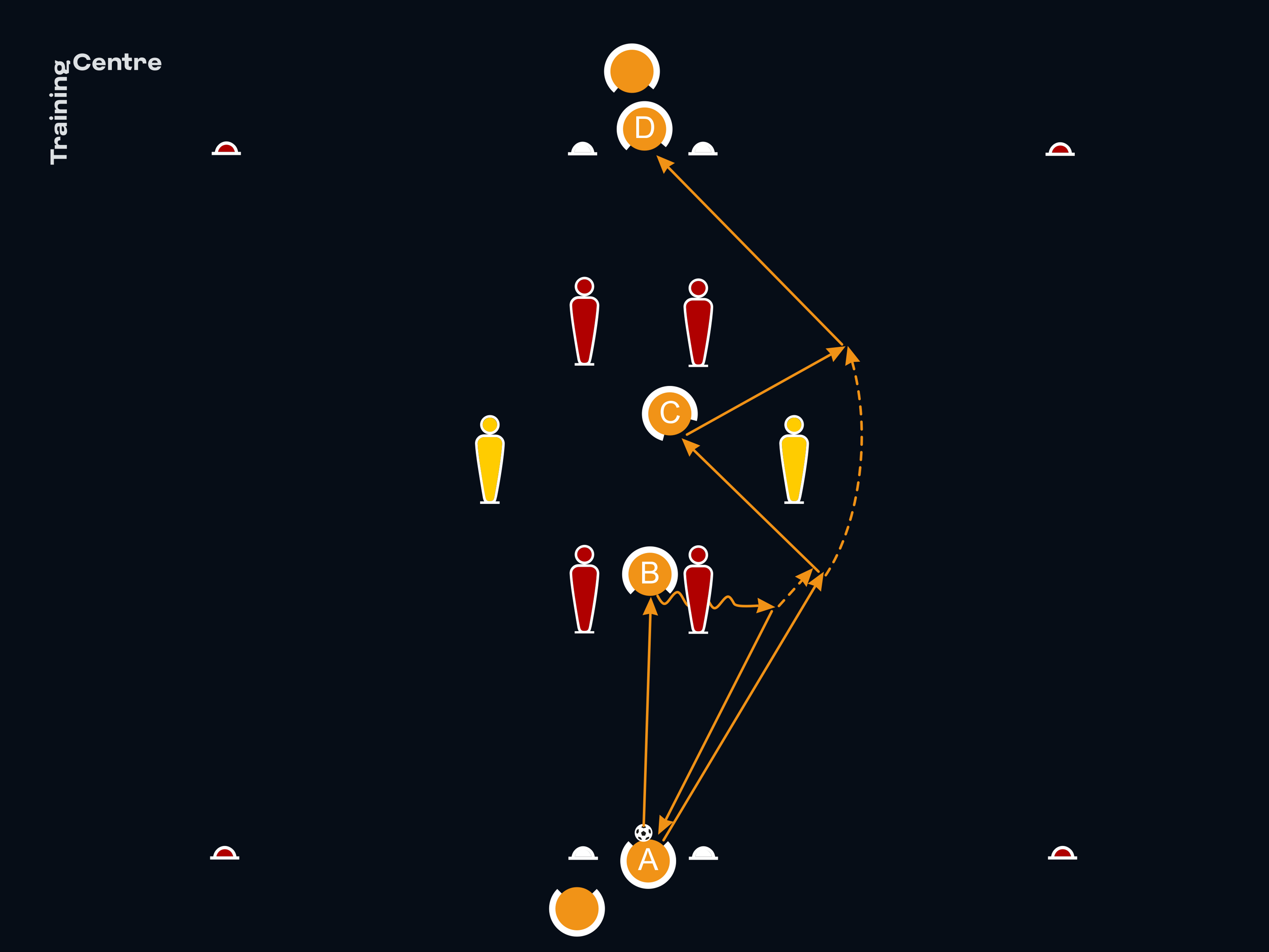
-
A plays a straight pass between the mannequin gate to B.
-
B shifts the ball wide of the gate to play a short one-two with A, before moving away on the half-turn to receive the return pass.
-
B then plays a short give-and-go with C, before playing a pass to D at the starting position at the opposite end.
-
D then starts the next sequence with C.
-
A moves to B.
-
B moves to D.
-
Emphasise and encourage the one-touch and movement aspects of this drill.
-
Players should play with their heads up and scan the area they are receiving the pass from and the intended destination of their own pass.
-
Place the emphasis on playing a quality pass into the path of the next player in the sequence.
-
This drill is technically balanced, requiring an equal use of left and right foot.
-
In terms of coordination/cohesion, the focus should be on one- and two-touch, quick feet coordination in tight spaces, emphasising movement and passing combinations while facing play to move away turning forward.
-
For technical balance, when moving from between the gate to the left of it, B can shift the ball wide of the gate with either foot to then play a left-footed return pass to A. After the short give-and-go (with either foot) at the wide mannequin, B should play a right-footed pass to the player at the opposite end.
-
The opposite applies when moving to the right of the gate, with a right-footed pass back to A and a left-footed pass to D.
Drill 9: moving away diagonally, creating space and letting the ball run
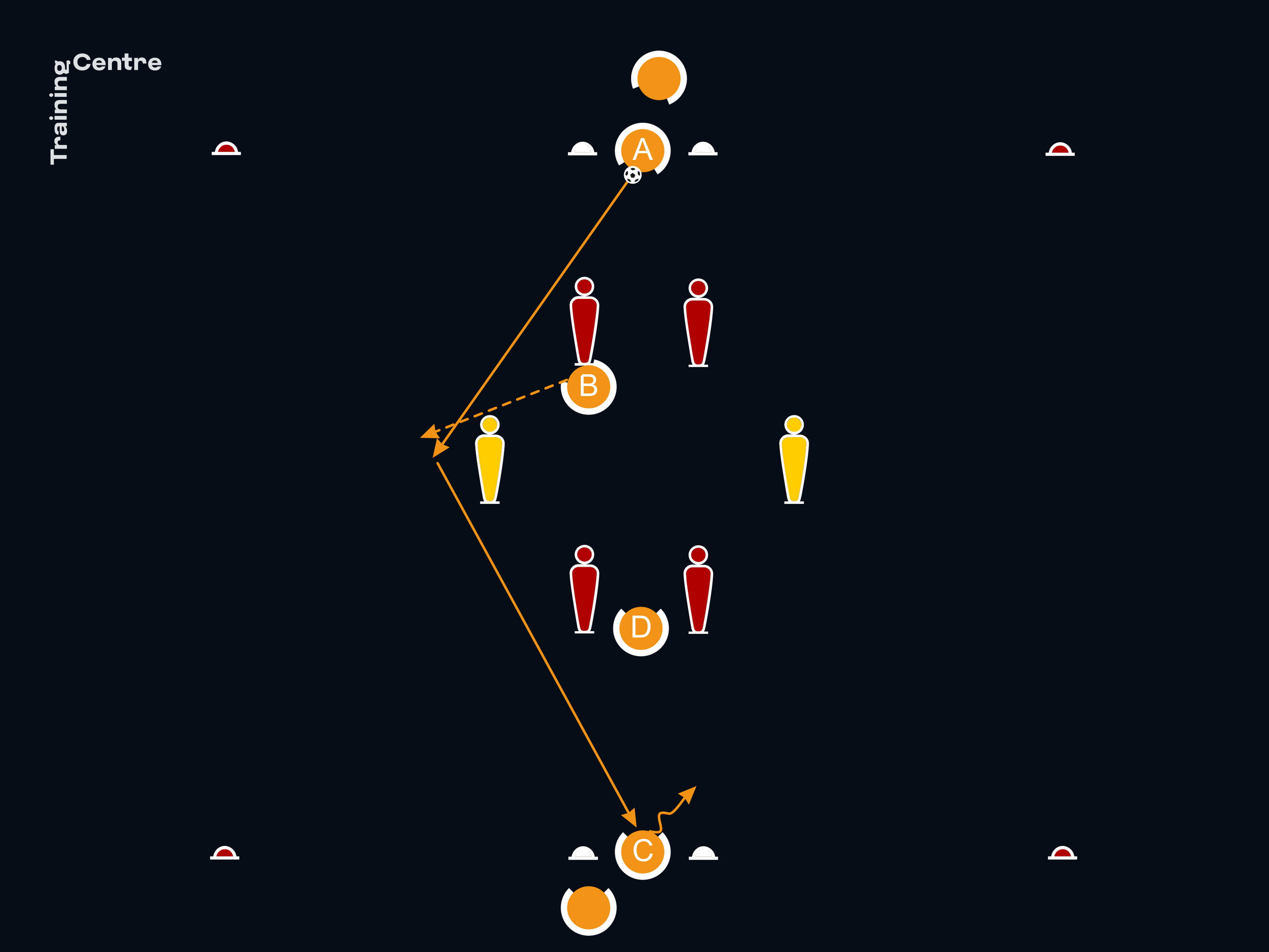
-
A plays a diagonal pass towards the wide mannequin to meet B's angled, half-turn run.
-
After moving out wide, B meets the ball and plays a first-time pass to C, who is situated at the opposite end.
-
C then starts the next sequence with D.
-
Every player follows their pass to ensure rotation.
-
A moves to B.
-
B moves to C.
-
Emphasise and encourage the one-touch and movement aspects of this drill.
-
Players should play with their heads up and scan the area they are receiving the pass from and the intended destination of their own pass.
-
Place the emphasis on playing a quality pass into the path of the next player in the sequence.
-
NB: to promote complete technical balance, the directions should be inverted in the following sequence to encourage efficient movement and two-footedness.
-
For technical balance, during the clockwise rotation, A should move the ball to the left while turning out, before playing a left-footed pass to B. During the anticlockwise rotation, the emphasis is on right-footed passing.
-
In terms of coordination/cohesion, the focus is on B's timing and technique to move diagonally half-turned forward, creating the space to let the ball run and play a first-time forward pass.
-
For technical balance, during the clockwise rotation, B should try to play a left-footed, first-time pass towards the left foot of C, who is positioned at the opposite end of the playing area. During the anticlockwise rotation, the emphasis is on playing right-footed passes towards A's right foot.
Drill 10: quality of the first touch as the basis for the second (small grid)

-
A advances with the ball towards the first mannequin gate, plays a long, straight pass to B that goes through the second mannequin gate and follows the pass.
-
B then has the freedom to decide whether to continue the sequence to the right or left and plays the ball quickly to C or D with their second touch and follows the pass.
-
C or D appears from slightly behind the wide mannequin and moves forward on the half-turn.
-
If the quality of the pass from B is good enough, C or D looks to open up into a full forward position, move the ball beyond the wide mannequin and play a diagonal pass with their second touch to the next player in position A.
-
The next player in position A starts the following sequence.
-
NB: the diagonal pass from B should change direction left or right with every rotation of the sequence.
-
Every player follows their pass to ensure rotation.
-
A moves to B.
-
B moves to C or D.
-
C or D moves to A.
-
To help raise the tempo and enhance the level of technical coordination, encourage C or D to play the pass into player A's path, between A's starting position and the mannequin gate.
-
Emphasise and encourage the one-touch and movement aspects of this drill.
-
Players should play with their heads up and scan the area they are receiving the pass from and the intended destination of their own pass.
-
Place the emphasis on playing a quality pass into the path of the next player in the sequence.
-
This drill is technically balanced, requiring an equal use of left and right foot.
-
The focus is on high-tempo technical coordination in tight spaces, with specific emphasis on the quality of the first touch to set the ball and play quick direction-change passing, and on the coordination to meet a weighted ball with a first-time pass.
-
In terms of coordination/cohesion, the emphasis is on encouraging A to step in and shif the ball forward, before playing the straight pass with whichever foot is appropriate through both gates towards B.
-
In terms of coordination/cohesion, the emphasis is on encouraging B to meet the ball first-time with whichever foot is appropriate to play a good-quality pass into C or D's path.
-
B should move the ball on the first touch with whichever foot is most suitable, but try to play a left-footed diagonal forward pass to the left. The opposite applies in the case of right-footed diagonal forward passes to the right.
-
In terms of coordination/cohesion, C or D should be encouraged to play a first-time pass.
-
C should play a right-footed diagonal pass to A. The opposite applies for D, i.e. a left-footed pass should be played.
Drill 11: multiple rotations: 1) get in behind 2) give-and-go 3) move inside
-
There are a total of three movement rotations for the main player, who is B.
-
Rotation 1: at the starting corner, A plays a diagonal pass beyond the wide yellow mannequin into the path of B, who makes a short, curved run in behind the wide mannequin to meet the ball, and, if possible, plays a first-time diagonal pass to C at the opposite starting position.
-
Rotation 2: B changes direction, moving out towards the wide yellow mannequin. C plays a diagonal pass into the path of B, who plays a one-two with D, meeting the return ball with a first-time pass to A.
-
Rotation 3: B moves inside towards the red mannequin gate. A plays a pass between the gate and into the path of B, who moves the ball forward on their first touch, before playing a second-touch diagonal pass towards C at the opposite corner.
-
A moves to B, only after playing the final pass to B.
-
B moves to C.
-
C starts the next sequence with D.
-
Emphasise and encourage the one-touch and movement aspects of this drill.
-
Players should play with their heads up and scan the area they are receiving the pass from and the intended destination of their own pass.
-
Place the emphasis on playing a quality pass into the path of the next player in the sequence.
-
The focus is on various movement and technique scenarios that are combined into one continuous repetition of multiple interactions with the ball, emphasising high-tempo coordination and cohesion to ensure one- and two-touch passing and quality of movement.
-
In terms of coordination/cohesion, the focus in rotations 1 and 2 should be on encouraging B to play first-time passes.
-
For technical balance in rotation 1, when starting with a right-to-left diagonal pass from A, B should meet the ball with a first-time, left-footed diagonal pass to C.
-
Rotation 2: after playing a short one-two with D at the wide mannequin, B should meet the return ball with a right-footed diagonal pass back to A.
-
Rotation 3: B should meet the ball early with their right foot, nudging it beyond the gate to play a pass across to the opposite corner.
-
When starting the first rotation with a left-to-right diagonal pass from A, B should play a right-footed diagonal pass to the player at the opposite corner. In the second rotation, after the one–two, B should play a left-footed pass diagonally to A. In the third rotation, B should meet the ball early with their left foot.





















